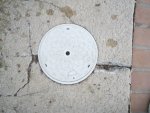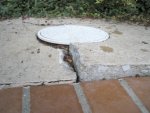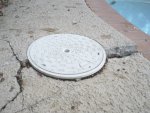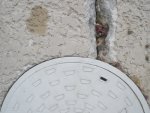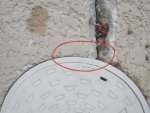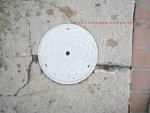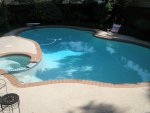The deck surrounding my pool is broken and uplifted in several spots due to poor maintenance by previous owners. One of these broken areas happens to be at the only skimmer for the pool, and is causing pressure to be applied to it, thus deforming it slightly. Here are several pics to illustrate the problem:[attachment=2:q20q8ib1]P8020073.JPG[/attachment:q20q8ib1][attachment=1:q20q8ib1]P8020074.JPG[/attachment:q20q8ib1][attachment=0:q20q8ib1]P8020075.JPG[/attachment:q20q8ib1]continued in next post...
broken deck putting pressure on skimmer
- Thread starter Beez
- Start date
You are using an out of date browser. It may not display this or other websites correctly.
You should upgrade or use an alternative browser.
You should upgrade or use an alternative browser.
[attachment=2:2ic6bgsp]P8020076.JPG[/attachment:2ic6bgsp]
So here is my question: Since the deck is already broken, would it be wise to break it further to eliminate the stress to the skimmer?
Point of applied pressure:[attachment=1:2ic6bgsp]point of pressure.jpg[/attachment:2ic6bgsp]
Proposed break:[attachment=0:2ic6bgsp]proposed break.jpg[/attachment:2ic6bgsp]As far as I know, the deck has moved as much as it is going to move, but I'm afraid if it moves any further it might crack the skimmer.
Any thoughts? Comments?
Thanks,
Dave
So here is my question: Since the deck is already broken, would it be wise to break it further to eliminate the stress to the skimmer?
Point of applied pressure:[attachment=1:2ic6bgsp]point of pressure.jpg[/attachment:2ic6bgsp]
Proposed break:[attachment=0:2ic6bgsp]proposed break.jpg[/attachment:2ic6bgsp]As far as I know, the deck has moved as much as it is going to move, but I'm afraid if it moves any further it might crack the skimmer.
Any thoughts? Comments?
Thanks,
Dave
Attachments
Oh, BTW, before anyone mentions it, I realize the best solution would be to replace the deck entirely, but that is not an option at this point.  :lol:
:lol:
The experts will be along soon but I'd cut it about 2" from where you have the line. I'd then seal all the cracks with a good caulking or a pourable grout. Siliconized latex concrete caulk is your best bet and most big box stores carry it. Polyurethane would be the second choice.
That is only one of the areas of movement though...here are a couple of more pics illustrating a more severe movement of the deck:Bama Rambler said:The experts will be along soon but I'd cut it about 2" from where you have the line. I'd then seal all the cracks with a good caulking or a pourable grout. Siliconized latex concrete caulk is your best bet and most big box stores carry it. Polyurethane would be the second choice.
The entire pool:[attachment=1:2iec2cjh]pool pic.jpg[/attachment:2iec2cjh]
A close up of the worst damage:[attachment=0:2iec2cjh]pool pic closeup.jpg[/attachment:2iec2cjh]
I guess what I'm getting at is that really the seal between coping and deck needs to be replaced all the way around the pool. I wonder if it is too late given the amount of movement in the close up? Can you seal a gap that wide?
Thanks for the response,
Dave
Attachments
wmshay6
0
WOW!! That's a lotta movement.
Looks like settlement from lack of proper compaction. Either that or you have volatile clay soils that move a lot in wet / dry cycles. I'm not familiar with the latter.
Are you convinved that there won't be additional movement?
For the skimmer, I agree with 'Bama cut it back. In fact I would cut a rectangle all the way around the skimmer, leaving 6" or space betweeen the cut and skimmer. Then I would repour the small area I cut out.
I think a relief cut might work somewhat for where the chair is sitting. It won't be ideal, but would probably be better than the current situation. Basically, rent a large gas powered concrete saw and cut a relief cut in the slab a few feet back from the edge of the pool. That might allow the concrete to settle in more in line with the coping.
I don't think that's a maintenance issue from the previous owners, I think its a bad ground prep issue before the deck was poured.
Looks like settlement from lack of proper compaction. Either that or you have volatile clay soils that move a lot in wet / dry cycles. I'm not familiar with the latter.
Are you convinved that there won't be additional movement?
For the skimmer, I agree with 'Bama cut it back. In fact I would cut a rectangle all the way around the skimmer, leaving 6" or space betweeen the cut and skimmer. Then I would repour the small area I cut out.
I think a relief cut might work somewhat for where the chair is sitting. It won't be ideal, but would probably be better than the current situation. Basically, rent a large gas powered concrete saw and cut a relief cut in the slab a few feet back from the edge of the pool. That might allow the concrete to settle in more in line with the coping.
I don't think that's a maintenance issue from the previous owners, I think its a bad ground prep issue before the deck was poured.
wmshay6,
Thanks for the response! My responses below are in red.
Thanks for the response! My responses below are in red.
wmshay6 said:WOW!! That's a lotta movement.
Yes, I agree! Kind of worried me when I bought the house, but I decided to take the risk that the movement wouldn't harm the integrity of the pool in any way before I could replace the deck.
Looks like settlement from lack of proper compaction. Either that or you have volatile clay soils that move a lot in wet / dry cycles. I'm not familiar with the latter.
I think our North Texas soils may actually be prone to movement, although I still think the movement is a little extreme given our somewhat volatile soil.
Are you convinved that there won't be additional movement?
I'm not 100% convinced that there won't be additional movement, but it looks to have happened some years ago. I don't know if there is even any room for any more movement!
For the skimmer, I agree with 'Bama cut it back. In fact I would cut a rectangle all the way around the skimmer, leaving 6" or space betweeen the cut and skimmer. Then I would repour the small area I cut out.
An excellent idea! However, after posting this question I have looked at the situation a little more closely. At first, I thought the skimmer itself was in jeopardy from the movement, but upon closer inspection I can see that the skimmer is not under pressure like I first thought. But rather, the "top" section of the skimmer is actually detached by design and has "floated" with the deck movement. It is this top section that is under pressure, not the skimmer itself. In other words, if the part of the skimmer that is under pressure does indeed crack, ther will be no water loss from the skimmer. It is like a lid fro a lack of better description.
I think a relief cut might work somewhat for where the chair is sitting. It won't be ideal, but would probably be better than the current situation. Basically, rent a large gas powered concrete saw and cut a relief cut in the slab a few feet back from the edge of the pool. That might allow the concrete to settle in more in line with the coping.
Are you thinking a cut that would be parallel with the coping?
I don't think that's a maintenance issue from the previous owners, I think its a bad ground prep issue before the deck was poured.
Well, that makes me feel a lot better about the prospect of replacing the deck! I have been worried that even if I replace it, the same thing may happen all over again!
I have one more question about cutting the deck. I have been advised that the deck material contains asbestos. Is there any special precaution I need to take when cutting it considering this asbestos content?
Thanks again for taking the time to write, and sorry for my wordy response!
wmshay6
0
I wouldn't cut parallel because it would be hard to duplicate the curve. I would cut a straight line to sort of lop off that part that is jutting above the coping. A straight line that passes somewhere underneath the chair in the picture. Picture a giant backwards "D" where the curve is your pool edge and the straight edge is your cut.
I've not had much exposure to asbestos in concrete. Knowing when the concrete was poured would help to determine if you should worry. Asbestos is added to concrete sometimes to enhance strength and chemical resistance. Asbestos was used in concrete until the early 1990s I believe. A concrete saw would definitely make hazardous dust- so maybe that route is not a good one.
I've not had much exposure to asbestos in concrete. Knowing when the concrete was poured would help to determine if you should worry. Asbestos is added to concrete sometimes to enhance strength and chemical resistance. Asbestos was used in concrete until the early 1990s I believe. A concrete saw would definitely make hazardous dust- so maybe that route is not a good one.
The asbestos is in the Cool Deck(sp?). Not sure if it is a coating on the concrete slab, or if the asbestos is mixed into the slab itself... Not good either way.
Beez, sorry I missed this last week 
If you use a wet saw for the cutting and have a particle mask on (and clean up the mess while it's still 'mud'), asbestos ought not be an issue
As for the cuts, do as wmshay says and cut ~ 6" around the skimmer and remove the old crete. Instead of repouring concrete in that area, fill the missing crete in with gravel (white looks nice) so if you need to access the outside of the skimmer or the lines, you won't have to remove the new crete to get down there :idea:
If you use a wet saw for the cutting and have a particle mask on (and clean up the mess while it's still 'mud'), asbestos ought not be an issue
As for the cuts, do as wmshay says and cut ~ 6" around the skimmer and remove the old crete. Instead of repouring concrete in that area, fill the missing crete in with gravel (white looks nice) so if you need to access the outside of the skimmer or the lines, you won't have to remove the new crete to get down there :idea:
waste said:Beez, sorry I missed this last week
Hey, no problem, I appreciate the help whenever I get it!
If you use a wet saw for the cutting and have a particle mask on (and clean up the mess while it's still 'mud'), asbestos ought not be an issue
OK, so how much skill does this take? Never used a concrete saw before...
As far as the asbestos goes, is the Cool Deck a thin layer on top of a slab of concrete, or is it the entire slab?
As for the cuts, do as wmshay says and cut ~ 6" around the skimmer and remove the old crete. Instead of repouring concrete in that area, fill the missing crete in with gravel (white looks nice) so if you need to access the outside of the skimmer or the lines, you won't have to remove the new crete to get down there :idea:
Great idea, the gravel around the skimmer.
Are you of the same mind as wmshay, that a relief cut behind the worst movement(see close up pic with chair) might reposition the deck to align with coping?
wmshay6
0
Where are you getting the asbestos info?? Is someone telling you this or was it disclosed to you somehow?
I think this is the MSDS for the stuff you are referring to.
http://www.mortex.com/pdf/MSDS-KoolDeck.pdf
It would appear that the coating does NOT contain asbestos. The MSDS is pretty nonspecific about what it does contain, but if it contained asbestos, there would be warnings about it in the MSDS. In fact the MSDS states specifically that there are no reportable ingredients in KookDeck.
That means that if there is asbestos, it's in the underlying concrete as a strength additive. Can't say for sure if it's there or not.
I think this is the MSDS for the stuff you are referring to.
http://www.mortex.com/pdf/MSDS-KoolDeck.pdf
It would appear that the coating does NOT contain asbestos. The MSDS is pretty nonspecific about what it does contain, but if it contained asbestos, there would be warnings about it in the MSDS. In fact the MSDS states specifically that there are no reportable ingredients in KookDeck.
That means that if there is asbestos, it's in the underlying concrete as a strength additive. Can't say for sure if it's there or not.
This info is word of mouth from the pool inspector I hired to assess the pool before I bought the house. He pointed at the glints of light reflected from the surface of the deck, and told me it was asbestos. He said it was used in the material as an insulator to keep the deck "cool" up until the early '80s.wmshay6 said:Where are you getting the asbestos info?? Is someone telling you this or was it disclosed to you somehow?
But you are correct that I really don't know for sure it's in there. I do know the pool and deck were built around 1977.
wmshay6
0
OK- got it now. The MSDS I posted is for current day stuff- but the manufacturer can tell you about 1977. I don't think material glinting in the sun would be proper evidence of asbestos. But if it were my pool, I'd want to verify there is not any in the coating before sawing. I'm starting to be of the same mind as waste- wear a good respirator and keep a hose handy to keep everything wet to keep dust down and you should be OK.
While you're figuring everything out- you can take a look here:
http://www.geocelusa.com/
These are the caulks/sealants I would use in the cracks after cutting- or whatever you decide.
Specifically this one:
http://www.geocelusa.com/php/oic/produc ... duct_id=53
Good luck with it and keep the forum posted with lots of PICTURES!!!
While you're figuring everything out- you can take a look here:
http://www.geocelusa.com/
These are the caulks/sealants I would use in the cracks after cutting- or whatever you decide.
Specifically this one:
http://www.geocelusa.com/php/oic/produc ... duct_id=53
Good luck with it and keep the forum posted with lots of PICTURES!!!
Thread Status
Hello , This thread has been inactive for over 60 days. New postings here are unlikely to be seen or responded to by other members. For better visibility, consider Starting A New Thread.


